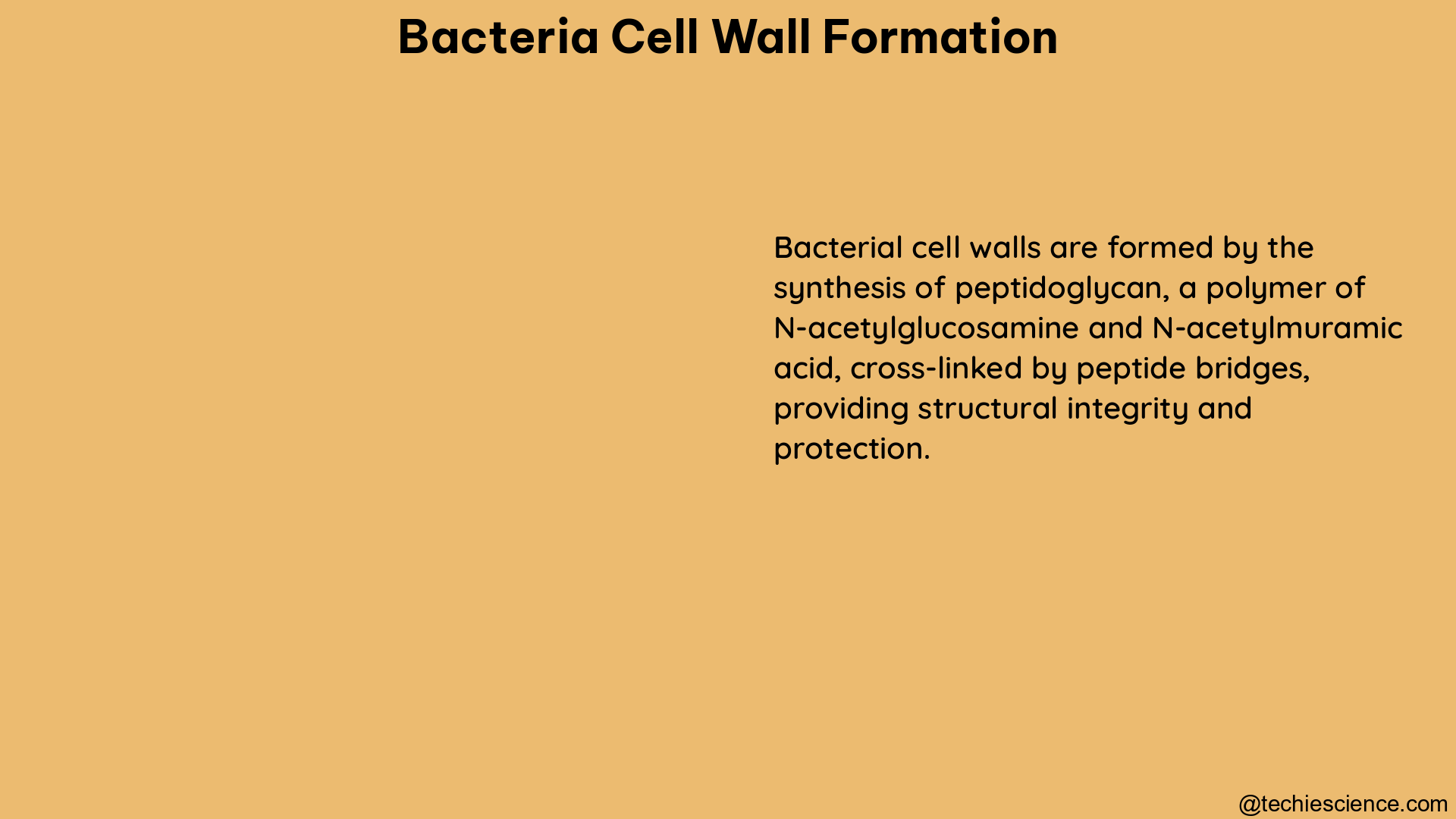Bacteria cell wall formation is a complex and intricate process that involves the synthesis and remodeling of peptidoglycan (PG), a crucial component of the bacterial cell wall. The thickness, organization, and composition of PG vary among different bacterial species, and its synthesis is essential for bacterial viability, growth, and survival.
Understanding the Bacterial Cell Wall Structure
The bacterial cell wall is a multi-layered structure that provides structural integrity, protection, and shape to the bacterial cell. It is composed of several key components, including:
- Peptidoglycan (PG): A polymer of N-acetylglucosamine (GlcNAc) and N-acetylmuramic acid (MurNAc) cross-linked by short peptide chains. PG is the primary structural component of the bacterial cell wall.
- Teichoic acids: Anionic polymers found in the cell walls of Gram-positive bacteria, which play a role in cell wall integrity, cell division, and cell surface properties.
- Lipopolysaccharides (LPS): A complex glycolipid found in the outer membrane of Gram-negative bacteria, which contributes to the structural integrity and permeability of the cell wall.
- Proteins: Various proteins embedded in the cell wall, such as porins, enzymes, and surface receptors, which perform essential functions.
The thickness and organization of the cell wall can vary significantly between Gram-positive and Gram-negative bacteria. Gram-positive bacteria typically have a thicker PG layer (20-80 nm), while Gram-negative bacteria have a thinner PG layer (2-7 nm) and an additional outer membrane.
Peptidoglycan Synthesis and Remodeling

The synthesis and remodeling of PG are central to bacterial cell wall formation. This process involves several key steps:
- Precursor Synthesis: The PG precursor, UDP-N-acetylmuramyl-pentapeptide, is synthesized in the cytoplasm through a series of enzymatic reactions.
- Translocation: The PG precursor is then translocated across the cytoplasmic membrane by a flippase enzyme, such as MurJ or Amj, to the periplasmic space.
- Polymerization: In the periplasmic space, the PG precursor is polymerized by glycosyltransferases, which catalyze the formation of the glycan backbone.
- Cross-linking: The glycan strands are then cross-linked by transpeptidases, which form peptide bonds between the peptide side chains, creating a rigid and stable PG network.
- Remodeling: During cell growth and division, the PG layer is continuously remodeled by various hydrolytic enzymes, such as autolysins and endopeptidases, which cleave and rearrange the PG structure.
The regulation and coordination of these PG synthesis and remodeling processes are crucial for maintaining the integrity and shape of the bacterial cell wall.
Visualization and Characterization Techniques
Advances in microscopy and analytical techniques have provided valuable insights into the structure and dynamics of bacterial cell walls. Some of the key techniques used to study PG synthesis and remodeling include:
- Cryogenic Electron Tomography (cryo-ET): This technique allows for the high-resolution, three-dimensional visualization of the division site architecture and PG biogenesis dynamics in live bacterial cells, as demonstrated in the study on Escherichia coli.
- Fluorescence Microscopy: Fluorescent labeling of PG precursors or cell wall-associated proteins enables the real-time monitoring of PG synthesis and remodeling processes during bacterial growth and division.
- Atomic Force Microscopy (AFM): AFM can be used to measure the thickness and organization of the PG layer, as well as to visualize the surface topography of live bacterial cells, as shown in the study on Staphylococcus aureus and Bacillus subtilis.
- Chemical and Biochemical Techniques: Techniques such as isotopic labeling, metabolic probes, and the isolation of critical intermediates have provided valuable insights into the biochemistry of cell wall biogenesis, as discussed in the Chemical Biology review.
These advanced techniques have been instrumental in elucidating the complex mechanisms underlying bacterial cell wall formation and have opened new avenues for understanding the role of the cell wall in bacterial physiology, growth, and division.
Factors Influencing Bacterial Cell Wall Formation
Several factors can influence the synthesis and remodeling of the bacterial cell wall, including:
- Bacterial Species and Strain: The thickness, composition, and organization of the PG layer can vary significantly between different bacterial species and even between strains within the same species.
- Growth Conditions: Environmental factors, such as nutrient availability, pH, temperature, and osmotic pressure, can affect the rate and regulation of PG synthesis and remodeling.
- Cell Cycle and Division: The cell wall must be continuously remodeled to accommodate cell growth and division, with the division apparatus playing a crucial role in coordinating these processes.
- Genetic Regulation: The expression and activity of genes involved in PG synthesis, translocation, and remodeling are tightly regulated to ensure the proper formation and maintenance of the cell wall.
- Cell Wall-Targeting Antibiotics: Certain antibiotics, such as β-lactams and glycopeptides, target and disrupt specific steps in the PG synthesis and remodeling pathways, leading to cell wall weakening and ultimately cell death.
Understanding these factors and their interplay is essential for developing effective strategies to manipulate or inhibit bacterial cell wall formation, which has important implications in the fields of microbiology, biotechnology, and antimicrobial drug development.
Conclusion
Bacterial cell wall formation is a complex and dynamic process that involves the synthesis and remodeling of peptidoglycan, a crucial structural component of the bacterial cell wall. The thickness, organization, and composition of the cell wall can vary significantly among different bacterial species and strains, and its formation is essential for bacterial viability, growth, and survival.
Advances in microscopy and analytical techniques have provided valuable insights into the mechanisms underlying cell wall biogenesis, enabling researchers to visualize and characterize the structure and dynamics of the bacterial cell wall. Understanding the factors that influence cell wall formation is crucial for developing effective strategies to manipulate or inhibit this process, with important implications in various fields, including microbiology, biotechnology, and antimicrobial drug development.
References:
- Brown, A. R., Gordon, R. A., Hyland, S. N., & Grimes, C. L. (2020). Chemical biology tools for examining the bacterial cell wall. Chemical biology, 17(8), 1217-1232.
- Navarro, P. P., Vettiger, A., Ananda, V. Y., … & VanNieuwenhze, M. S. (2022). Cell wall synthesis and remodelling dynamics determine division site architecture and cell shape in Escherichia coli. Nature microbiology, 7(11), 1621-1634.
- Roux, A., … & Armitage, J. P. (2020). The Architecture of the Gram Positive Bacterial Cell Wall. PMC, 7308169.

Hi….I am Shravanthi Vikram, I have completed my master’s in Bioinformatics and have 10 years of teaching experience in Biology.
Let’s connect through LinkedIn-